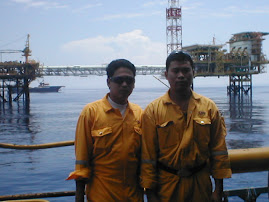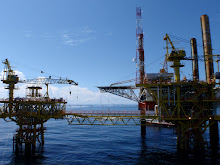When an ultrasounic wave passes through an interface between two materials at
 an oblique angle, and the materials have different indices of refraction, both reflected and refracted waves are produced. This also occurs with light, which is why objects seen across an interface appear to be shifted relative to where they really are. For example, if you look straight down at an object at the bottom of a glass of water, it looks closer than it really is. A good way to visualize how light and sound refract is to shine a flashlight into a bowl of slightly cloudy water noting the refraction angle with respect to the incident angle.
an oblique angle, and the materials have different indices of refraction, both reflected and refracted waves are produced. This also occurs with light, which is why objects seen across an interface appear to be shifted relative to where they really are. For example, if you look straight down at an object at the bottom of a glass of water, it looks closer than it really is. A good way to visualize how light and sound refract is to shine a flashlight into a bowl of slightly cloudy water noting the refraction angle with respect to the incident angle.Refraction takes place at an interface due to the different velocities of the acoustic waves within the two materials. The velocity of sound in each material is determined by the material properties (elastic modulus and density) for that material. In the animation below, a series of plane waves are shown traveling in one material and entering a second material that has a higher acoustic velocity. Therefore, when the wave encounters the interface between these two materials, the portion of the wave in the second material is moving faster than the portion of the wave in the first material. It can be seen that this causes the wave to bend.
Snell's Law describes the relationship between the angles and the velocities of the waves. Snell's law equates the ratio of material velocities V1 and V2 to the ratio of the sine's of incident (Q1) and refracted (Q2) angles, as shown in the following equation.
Snell's Law describes the relationship between the angles and the velocities of the waves. Snell's law equates the ratio of material velocities V1 and V2 to the ratio of the sine's of incident (Q1) and refracted (Q2) angles, as shown in the following equation.
Where:
VL1 is the longitudinal wave velocity in material 1.
VL2 is the longitudinal wave velocity in material 2.
VL1 is the longitudinal wave velocity in material 1.
VL2 is the longitudinal wave velocity in material 2.
Note that in the diagram, there is a reflected longitudinal wave (VL1' ) shown. This wave is reflected at the same angle as the incident wave because the two waves are traveling in the same material, and hence have the same velocities. This reflected wave is unimportant in our explanation of Snell's Law, but it should be remembered that some of the wave energy is reflected at the interface. In the applet below, only the incident and refracted longitudinal waves are shown. The angle of either wave can be adjusted by clicking and dragging the mouse in the region of the arrows. Values for the angles or acoustic velocities can also be entered in the dialog boxes so the that applet can be used as a Snell's Law calculator.
 When a longitudinal wave moves from a slower to a faster material, there is an incident angle that makes the angle of refraction for the wave 90o. This is know as the first critical angle. The first critical angle can be found from Snell's law by putting in an angle of 90° for the angle of the refracted ray. At the critical angle of incidence, much of the acoustic energy is in the form of an inhomogeneous compression wave, which travels along the interface and decays exponentially with depth from the interface. This wave is sometimes referred to as a "creep wave." Because of their inhomogeneous nature and the fact that they decay rapidly, creep waves are not used as extensively as Rayleigh surface waves in NDT. However, creep waves are sometimes more useful than Rayleigh waves because they suffer less from surface irregularities and coarse material microstructure due to their longer wavelengths.
When a longitudinal wave moves from a slower to a faster material, there is an incident angle that makes the angle of refraction for the wave 90o. This is know as the first critical angle. The first critical angle can be found from Snell's law by putting in an angle of 90° for the angle of the refracted ray. At the critical angle of incidence, much of the acoustic energy is in the form of an inhomogeneous compression wave, which travels along the interface and decays exponentially with depth from the interface. This wave is sometimes referred to as a "creep wave." Because of their inhomogeneous nature and the fact that they decay rapidly, creep waves are not used as extensively as Rayleigh surface waves in NDT. However, creep waves are sometimes more useful than Rayleigh waves because they suffer less from surface irregularities and coarse material microstructure due to their longer wavelengths.Wave Propagation
Ultrasonic testing is based on time-varying deformations or vibrations in materials, which is generally referred to as acoustics. All material substances are comprised of atoms, which may be forced into vibrational motion about their equilibrium positions. Many different patterns of vibrational motion exist at the atomic level, however, most are irrelevant to acoustics and ultrasonic testing. Acoustics is focused on particles that contain many atoms that move in unison to produce a mechanical wave. When a material is not stressed in tension or compression beyond its elastic limit, its individual particles perform elastic oscillations. When the particles of a medium are displaced from their equilibrium positions, internal (electrostatic) restoration forces arise. It is these elastic restoring forces between particles, combined with inertia of the particles, that leads to the oscillatory motions of the medium.
In solids, sound waves can propagate in four principle modes that are based on the way the particles oscillate. Sound can propagate as longitudinal waves, shear waves, surface waves, and in thin materials as plate waves. Longitudinal and shear waves are the two modes of propagation most widely used in ultrasonic testing. The particle movement responsible for the propagation of longitudinal and shear waves is illustrated below.
In solids, sound waves can propagate in four principle modes that are based on the way the particles oscillate. Sound can propagate as longitudinal waves, shear waves, surface waves, and in thin materials as plate waves. Longitudinal and shear waves are the two modes of propagation most widely used in ultrasonic testing. The particle movement responsible for the propagation of longitudinal and shear waves is illustrated below.

In longitudinal waves, the oscillations occur in the longitudinal direction or the direction of wave propagation. Since compressional and dilational forces are active in these waves, they are also called pressure or compressional waves. They are also sometimes called density waves because their particle density fluctuates as they move. Compression waves can be generated in liquids, as well as solids because the energy travels through the atomic structure by a series of comparison and expansion (rarefaction) movements.
In the transverse or shear wave, the particles oscillate at a right angle or transverse to the direction of propagation. Shear waves require an acoustically solid material for effective propagation, and therefore, are not effectively propagated in materials such as liquids or gasses. Shear waves are relatively weak when compared to longitudinal waves. In fact, shear waves are usually generated in materials using some of the energy from longitudinal waves.
Precision Velocity Measurements
Changes in ultrasonic wave propagation speed, along with energy losses, from interactions with a materials microstructures are often used to nondestructively gain information about a material's properties. Measurements of sound velocity and ultrasonic wave attenuation can be related to the elastic properties that can be used to characterize the texture of polycrystalline metals. These measurements enable industry to replace destructive microscopic inspections with nondestructive methods.
Of interest in velocity measurements are longitudinal wave, which propagate in gases, liquids, and solids. In solids, also of interest are transverse (shear) waves. The longitudinal velocity is independent of sample geometry when the dimensions at right angles to the beam are large compared to the beam area and wavelength. The transverse velocity is affected little by the physical dimensions of the sample.
Pulse-Echo and Pulse-Echo-Overlap Methods
Rough ultrasonic velocity measurements are as simple as measuring the time it takes for a pulse of ultrasound to travel from one transducer to another (pitch-catch) or return to the same transducer (pulse-echo). Another method is to compare the phase of the detected sound wave with a reference signal: slight changes in the transducer separation are seen as slight phase changes, from which the sound velocity can be calculated. These methods are suitable for estimating acoustic velocity to about 1 part in 100. Standard practice for measuring velocity in materials is detailed in ASTM E494.
Precision Velocity Measurements (using EMATs)
Electromagnetic-acoustic transducers (EMAT) generate ultrasound in the material being investigated. When a wire or coil is placed near to the surface of an electrically conducting object and is driven by a current at the desired ultrasonic frequency, eddy currents will be induced in a near surface region. If a static magnetic field is also present, these currents will experience Lorentz forces of the form
F = J x B
where F is a body force per unit volume, J is the induced dynamic current density, and B is the static magnetic induction.
The most important application of EMATs has been in nondestructive evaluation (NDE) applications such as flaw detection or material property characterization. Couplant free transduction allows operation without contact at elevated temperatures and in remote locations. The coil and magnet structure can also be designed to excite complex wave patterns and polarizations that would be difficult to realize with fluid coupled piezoelectric probes. In the inference of material properties from precise velocity or attenuation measurements, use of EMATs can eliminate errors associated with couplant variation, particularly in contact measurements.
Differential velocity is measured using a T1-T2---R fixed array of EMAT transducers at 0, 45°, 90° or 0°, 90° relative rotational directions depending on device configuration:

 EMAT Driver Frequency: 450-600 KHz (nominal)
EMAT Driver Frequency: 450-600 KHz (nominal)
Sampling Period: 100 ns
Time Measurement Accuracy:
Resolution 0.1 ns
Accuracy required for less than 2 KSI Stress Measurements: Variance 2.47 ns
Accuracy required for texture: Variance 10.0 Ns
W440
W420
W400
Time Measurement Technique
Fourier Transform-Phase-Slope determination of delta time between received RF bursts (T2-R) - (T1-R), where T2 and T1 EMATs are driven in series to eliminate differential phase shift due to probe liftoff.



 Slope of the phase is determined by linear regression of weighted data points within the signal bandwidth and a weighted y-intercept. The accuracy obtained with this method can exceed one part in one hundred thousand (1:100,000).
Slope of the phase is determined by linear regression of weighted data points within the signal bandwidth and a weighted y-intercept. The accuracy obtained with this method can exceed one part in one hundred thousand (1:100,000).




























No comments:
Post a Comment